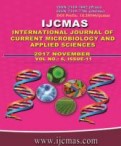


 National Academy of Agricultural Sciences (NAAS)
National Academy of Agricultural Sciences (NAAS)

|
PRINT ISSN : 2319-7692
Online ISSN : 2319-7706 Issues : 12 per year Publisher : Excellent Publishers Email : editorijcmas@gmail.com / submit@ijcmas.com Editor-in-chief: Dr.M.Prakash Index Copernicus ICV 2018: 95.39 NAAS RATING 2020: 5.38 |
Rhizome rot (Pythium aphanidermatum) is one of the most wide spread, destructive disease of turmeric (Curcuma longa L.), which accounts for about 30 to 80 per cent yield losses. All the fungicides tested significantly inhibited mycelial growth of P. aphanidermatum, over untreated control. Average mycelial growth inhibition recorded with the test systemic fungicides was ranged from 73.32 (Propiconazole) to 100 (Metalaxyl) per cent. However, it was cent per cent with Metalaxyl (100 %), followed by Carbendazim (97.67 %), Azoxystrobin (94.55 %), Thiophanate methyl (94.15 %), Fosetyl-AL (86.64 %), Hexaconazole (85.76 %) and Difenconazole (82.85). Whereas, it was comparatively minimum with Propiconazole (73.32 %) and Penconazole (81.14 %). Average mycelial growth inhibition recorded with the test non systemic and contact fungicides was ranged from 50.94 (Metalaxyl 8 % WP + Mancozeb 64 % WP) to 100 (Carbendazim 12 WP + Mancozeb 63 WP) per cent. However, Carbendazim 12 WP + Mancozeb 63 WP gave cent per cent (100 %) mycelial inhibition. The next fungicides with significantly least mycelial growth were Copper oxychloride (97.36 %), followed by Chlorothalonil (76.16 %), Mancozeb (70.62 %). However, Metalaxyl 8 % WP + Mancozeb 64 % WP and Cymoxanil 8 % + Mancozeb 64 % WP were found less effective with minimum mycelial inhibition of 50.94 and 55.23 per cent, respectively.
 |
 |
 |
 |
 |